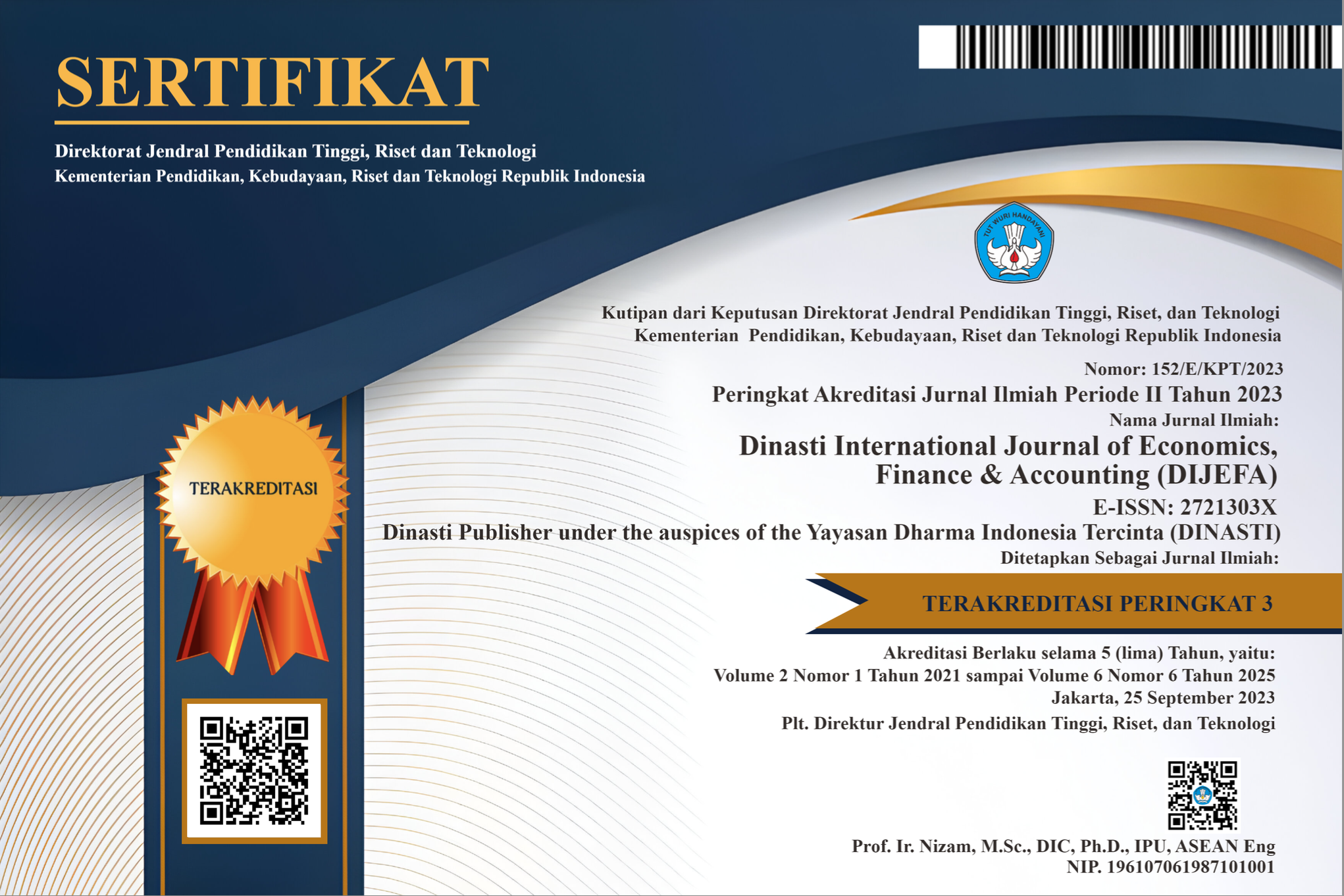Factors Influencing Industrial Agglomeration in Indonesia
DOI:
https://doi.org/10.38035/dijefa.v5i5.3394Keywords:
Agglomeration, Economic Growth, Investment, HDI, Population SizeAbstract
This study analyzes the factors affecting industrial agglomeration in Indonesia using panel data from 34 provinces during the 2012-2023 period. The analytical methods employed include Location Quotient (LQ) and panel data regression, with testing results indicating that the Fixed Effect model is the most appropriate. The findings reveal that economic growth and investment have a negative and significant impact on industrial agglomeration, while the Human Development Index (HDI) shows a negative but insignificant effect. On the other hand, population size has a positive and significant influence on agglomeration.
References
Adijaya, D. N. H. (2022). Analisis Faktor - Faktor Yang Mempengaruhi Aglomerasi Di Daerah Khusus Ibukota Jakarta. In Science (Vol. 7, Issue 1). Universitas Islam Indonesia.
Arsyad, L. (2010). Ekonomi Pembangunan. UPP STIM YKPN.
Audretsch, D. B., & Feldman, M. P. (2004). Knowledge spillovers and the geography of innovation. In In Handbook of regional and urban economics: Vol. Volume 4 (pp. 2713–2739). Elsevier. http://www.sciencedirect.com/science/article/B7P64-4FFPH84-2R/2/2c557f0d93ea190abcc8a573e7d47217
Azwina, R., Wardani, P., Sitanggang, F., & Silalahi, P. R. (2023). Strategi Industri Manufaktur Dalam Meningkatkan Percepatan Pertumbuhan Ekonomi Di Indonesia. Profit: Jurnal Manajemen, Bisnis Dan Akuntansi, 2(1), 44–55.
Duranton, G., & Puga, D. (2004). Micro-foundations of urban agglomeration economies. In In Handbook of regional and urban economics (Vol. 4, pp. 2063–2117). Elsevier. http://www.nber.org/papers/w9931
Duranton, G., & Puga, D. (2023). Urban Growth and Its Aggregate Implications. Econometrica, 91(6), 2219–2259. https://doi.org/10.3982/ecta17936
Edward L. Glaeser, Hedi D. Kallal, José A. Scheinkman, & Andrei Shleifer. (1992). Growth in Cities. In Journal of Political Economy (Vol. 100, Issue 6, pp. 1126–1152).
Emalia, Z. (2016). Determinan Aglomerasi Industri Manufaktur di Provinsi Jawa Barat. Jurnal Ekonomi Pembangunan, 2013, 145–151.
Eriandy, F. M. (2021). Analisis Aglomerasi Pada Koridor Ekonomi di Indonesia. Jurnal Ekonomi Akuntansi Dan Manajemen, 20(2), 134. https://doi.org/10.19184/jeam.v20i2.25775
Glaeser, E. L., & Gottlieb, J. D. (2008). The Economics of Place-Making Policies. Brookings Papers on Economic Activity, 155–253. https://doi.org/10.3390/proceedings1060663
Glaeser, E. L., & Gottlieb, J. D. (2009). The wealth of cities: Agglomeration economies and spatial equilibrium in the United States. Journal of Economic Literature, 47(4), 983–1028. http://www.nber.org/papers/w14806
Hanson, G. H. (1994). Localization Economies, Vertical Organization, and Trade. The American Economic Review, 86(5), 1266–1278.
Henderson, J. V. (2003). Marshall’s scale economies. Journal of Urban Economics, 53(1), 1–28. https://doi.org/10.1016/S0094-1190(02)00505-3
Jhingan M L. (2012). Ekonomi Pembangunan dan Perencanaan. Jakarta?: Raja Grafindo Persada.
Kasmir. (2019). Analisis Laporan Keuangan (Edisi 1). Jakarta?: PT Raja Grafindo Persada.
Kuchiki, A. (2002). Agglomeration of Exporting Firms in Industrial Zones in Northern Vietnam: Players and Institutions,. International Joint Research Project. Japan Institute of Developing Economies.
Kuncoro, M. (2002). Analisis Spasial dan Regional, Studi Aglomerasi dan Kluster Industri Indonesia. Yogyakarta?: UPP AMP YKPN.
Kuncoro, M. (2012). Masalah, Kebijakan Dan Politik Ekonomika Pembangunan. Jakarta?: Erlangga.
Liu, Y., Yang, M., & Cui, J. (2024). Urbanization, economic agglomeration and economic growth. Heliyon, 10(1), e23772. https://doi.org/10.1016/j.heliyon.2023.e23772
Martin, R., & Sunley, P. (1998). Slow convergence? The new endogenous growth theory and regional development. Economic Geography, 74(3), 201–227. https://doi.org/10.3166/ges.7.129-154
Mellander, C., & Florida, R. (2021). The Rise of Skills: Human Capital, the Creative Class, and Regional Development. In Handbook of Regional Science (Issue 266, pp. 707–719). https://doi.org/10.1007/978-3-662-60723-7_18
Moretti, E. (2012). The new geography of jobs. Houghton Mifflin Harcourt.
Mulyadi, S. (2008). Ekonomi Sumber Daya Manusia Dalam Perspektif Pembangunan. Jakarta?: Rajawali Press.
Nugroho, Y. D., & Wahyuni, K. T. (2020). Aglomerasi Dan Dinamika Industri Manufaktur Pada Era Revolusi Industri 4.0 Di Koridor Ekonomi Jawa. Seminar Nasional Official Statistics, 2019(1), 687–699. https://doi.org/10.34123/semnasoffstat.v2019i1.251
Nurdiman. (2008). Ekonomi Kependudukan. Jakarta?: Raja Grafindo Persada.
Puga, D. (2010). The magnitude and causes of agglomeration economies. Journal of Regional Science, 50(1), 203–219. https://doi.org/10.1111/j.1467-9787.2009.00657.x
Putri Salsabila, S., S, B., & Soeharjoto. (2019). Faktor-Faktor Yang Mempengaruhi Aglomerasi. Media Ekonomi, 27(2), 133–140.
Rahmawati, Y. O. (2019). Analisis Pengaruh Indeks Pembangunan Manusia (Ipm), Tingkat Partisipasi Angkatan Kerja (Tpak), Dan Pengeluaran Pemerintah Di Sektor Kesehatan Dan Pendidikan Terhadap Pertumbuhan Ekonomi Di Indonesia Periode 1995-2017. Jurnal Ilmiah Mahasiswa FEB Universitas Brawijaya, 10–10.
Silaen, M. L. M., & Esther, A. M. (2015). Pengaruh Investasi Dan Tenaga Kerja Terhadap Pdrb Sektor Industri Di Provinsi Jawa Barat. Media Ekonomi, 23(3), 189–198. https://doi.org/10.25105/me.v23i3.3521
Simarmata, Y. W., & Iskandar, D. D. (2022). Pengaruh Pengeluaran Pemerintah, Investasi, Jumlah Penduduk, Kemiskinan Terhadap Pertumbuhan Ekonomi Dan Indeks Pembangunan Manusia: Analisa Two Stage Least Square untuk Kasus Indonesia. Jurnal Dinamika Ekonomi Pembangunan, 5(1), 78–94. https://doi.org/10.14710/jdep.5.1.78-94
Sodik, J., & Iskandar, D. (2007). Aglomerasi Dan Pertumbuhan Ekonomi: Peran Karakteristik Regional Di Indonesia. Jurnal Ekonomi Dan Studi Pembangunan, 8, 117–129.
Storper, M., & Venables, A. J. (2004). Buzz: Face-to-face contact and the urban economy. Journal of Economic Geography, 4(4), 351–370. https://doi.org/10.1093/jnlecg/lbh027
Sukirno, S. (2015). Ekonomi Pembangunan: Proses, Masalah dan dasar Kebijakan. (Edisi Ke 2). Jakarta?: Kencana.
Tarigan, R. (2012). Ekonomi Regional Teori dan Aplikasi Edisi Revisi. Jakarta?: PT Bumi Aksara.
Tilaar, S. (2010). Tinjauan Sebaran Lokasi Aglomerasi Industri Di Indonesia. Tekno, 07(52), 90–96.
Todaro. (2006). Pembangunan Ekonomi (Edisi ke 9). Jakarta?: Erlangga.
Todaro P. Michael. (2000). Pembangunan Ekonomi Dunia Ketiga (Jilid I). Jakarta?: Erlangga.
Ucak, A. (2015). Adam Smith: The Inspirer of Modern Growth Theories. Procedia - Social and Behavioral Sciences, 195(284), 663–672. https://doi.org/10.1016/j.sbspro.2015.06.258
Wibowo, W. S. (2021). Analisis Determinan Aglomerasi Industri Di Jawa Barat Tahun 2015-2019.
Widarjono, A. (2012). Ekonometrika Pengantar dan Aplikasinya. Yogyakarta?: UPP STIM YKPN Yogyakarta.
Windasari, M. D., Ningsih, S., & Pravasanti, Y. A. (2021). Analisis Pengaruh Aglomerasi Industri, Angkatan Kerja, Dan Human Capital Investment Terhadap Pertumbuhan Ekonomi Kabupaten/Kota Di Provinsi Jawa Tengah Tahun 2017-2019. Jurnal Akuntansi Dan Pajak, 22(1), 372. https://doi.org/10.29040/jap.v22i1.2871
Wulandari, D., & Sakti, R. K. (2020). Analisis Pengaruh Pertumbuhan Ekonomi, Indeks Pembangunan Manusia, Aglomerasi Industri Pengolahan, Dan Angkatan Kerja Terhadap Disparitas Pendapatan. Jurnal Ilmiah, 1–15.
Zuliastri, F., Rindayati, W., & Asmara, A. (2018). Analisis Faktor Yang Memengaruhi Aglomerasi Industri Unggulan Daerah Dan Hubungannya Dengan Daya Saing Industri Daerah. Jurnal Ekonomi Dan Kebijakan Pembangunan, 2(2), 113–134. https://doi.org/10.29244/jekp.2.2.2013.113-134
Downloads
Published
How to Cite
Issue
Section
License
Copyright (c) 2024 Hizbul Khootimah Az Zaakiyyah

This work is licensed under a Creative Commons Attribution 4.0 International License.
Authors who publish their manuscripts in this journal agree to the following conditions:
- The copyright on each article belongs to the author(s).
- The author acknowledges that the Dinasti International Journal of Economics, Finance & Accounting (DIJEFA) has the right to be the first to publish with a Creative Commons Attribution 4.0 International license (Attribution 4.0 International (CC BY 4.0).
- Authors can submit articles separately, arrange for the non-exclusive distribution of manuscripts that have been published in this journal into other versions (e.g., sent to the author's institutional repository, publication into books, etc.), by acknowledging that the manuscript has been published for the first time in the Dinasti International Journal of Economics, Finance & Accounting (DIJEFA).


























































